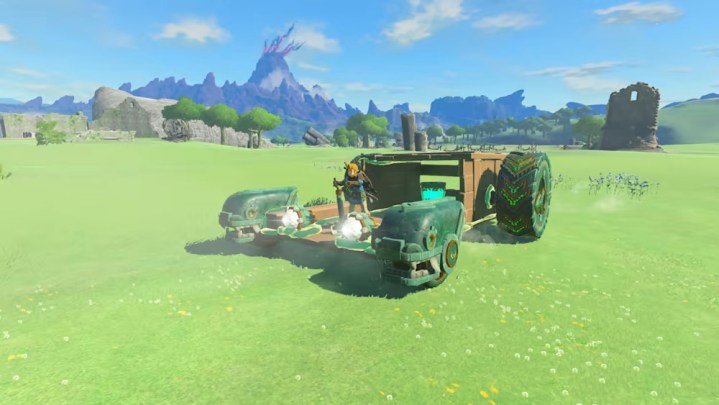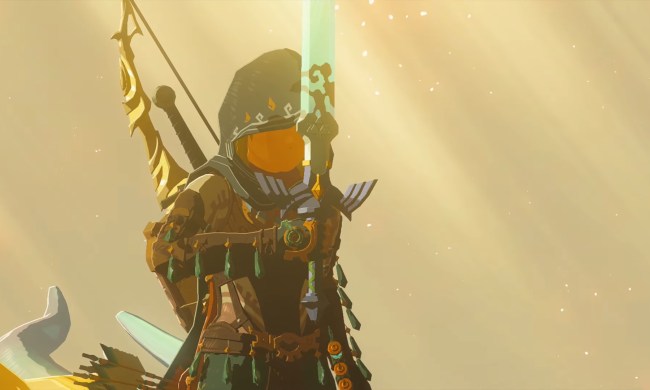After years of barely knowing anything about it, Nintendo has finally blown the lid off of The Legend of Zelda: Tears of the Kingdom. The company dropped a 10-minute deep dive into the open-world game today that focuses on some of its new features. The list includes a Recall ability that rewinds time and an Ascend skill that teleports Link through ceilings.
The talk of the town, though, is the new Fuse system, which doubles down on Breath of the Wild‘s most controversial system. The gameplay clip confirms that weapons can once again break in the sequel, as Link quickly smashes a stick by smacking it against an enemy a few times. In classic infomercial fashion, though, series producer Eiji Aonuma picks up another stick and seamlessly fuses it with a rock to create a more durable hammer.
Yes, it can still break — and that’s the point. With Tears of the Kingdom, Nintendo is better spelling out its design decision behind weapon degradation. And it’s doing that with an inventive new gameplay hook that could once again revolutionize the open-world genre.
Don’t get comfortable
Ever since The Legend of Zelda: Breath of the Wild launched in 2017, its item-breaking system has been a primary point of debate for fans. While some enjoy the idea, others have long prayed that it was a rough edge that would be smoothed over in a sequel. With the new peek at Tears of the Kingdom gameplay, Nintendo is making it clear that weapon durability has been a feature –not a bug — all along.
If I had to sum up Breath of the Wild‘s core design philosophy in one word, that would be “experimentation.” What’s so refreshing about it is that it treats its open world like a true sandbox that players can goof around in rather than a series of pretty landscapes to traverse between story beats. To this day, I still see videos of players discovering new tricks in the game that I never thought were possible. Even newer games that draw inspiration from it can’t claim the same.

Its combat system is a major part of that. Sure, you can go through the entire thing slashing enemies like a regular Zelda game, but you’d only be getting a surface view of what’s capable in it. For instance, you can kill an enemy by freezing it with an ice rod and then blowing it off a cliff with a gust of wind from a leaf. A lot of the joy comes from discovering interactions like that and seeing how far the system stretches. Breath of the Wild gets better the more players break out of their comfort zone and toss their usual instincts to the side. The goal isn’t to find the strongest sword.
For some, that philosophy has always been a tough pill to swallow. After all, it flies in the face of the entire series and challenges the modern idea of character “builds.” As much as I understand and appreciate what Nintendo is going for, the criticisms aren’t entirely unearned. For a game to hinge on player curiosity, it needs to do a good job at encouraging it. Breath of the Wild certainly gets part of that right by breaking Link’s toys after a while, but many of its most revelatory discoveries don’t come naturally. I wouldn’t realize how I could goof around with even the smallest branch until watching YouTube compilations of the game. Players who can’t stand the weapon breaking might not realize how much they can actually do with any old tool.
You can lead a horse to water, but you can’t make it lay out all its metal weapons to create an electrical current and skip over a dungeon puzzle.

That’s why Tears of the Kingdom‘s Fuse ability has me thrilled. In the demo, we see Link attaching an eyeball onto an arrow to create a homing shot. Later, he tacks a mushroom onto a shield, which creates a puff of smoke he can hide in when an enemy hits it. It’s a seemingly easy system for experimentation that only asks players to try combining two items. That’s far more streamlined than Breath of the Wild‘s hypothesis-driven gameplay where players would be left to think of ideas and test them out without guidance. It’s a smart way to gamify curiosity, even for players who don’t always know how to get creative.
With that system in place, weapon degradation already feels much better on paper. Anytime a weapon breaks, it’ll open an opportunity for players to quickly cobble together a new tool and see what happens. As long as the possibilities don’t feel limited, I can already imagine that I’ll be eager to try something new every chance I get. It’s a potentially revolutionary concept that could influence how developers think about combat in open-world games. Don’t drop me in a sandbox without giving me enough tools to build a castle.
The Legend of Zelda: Tears of the Kingdom launches on May 12 for Nintendo Switch.



